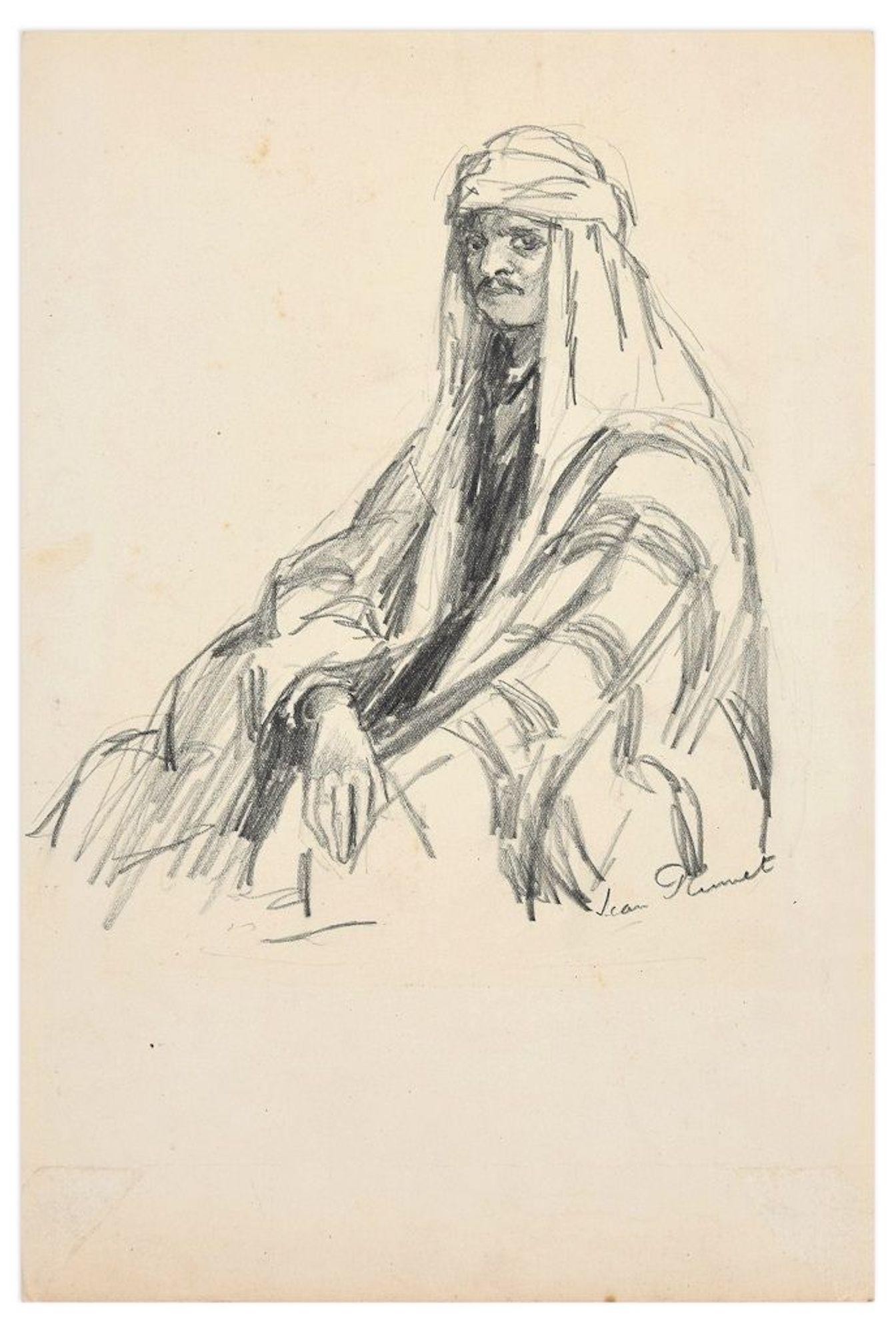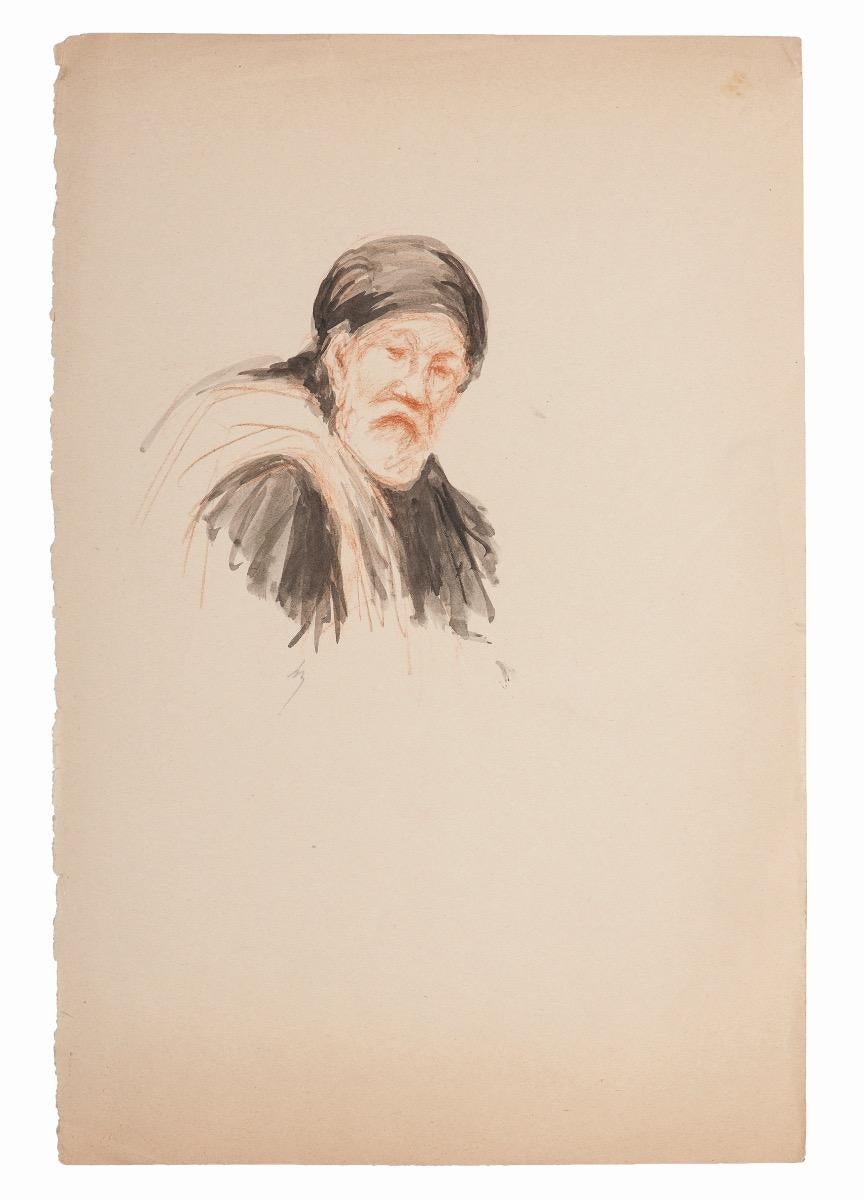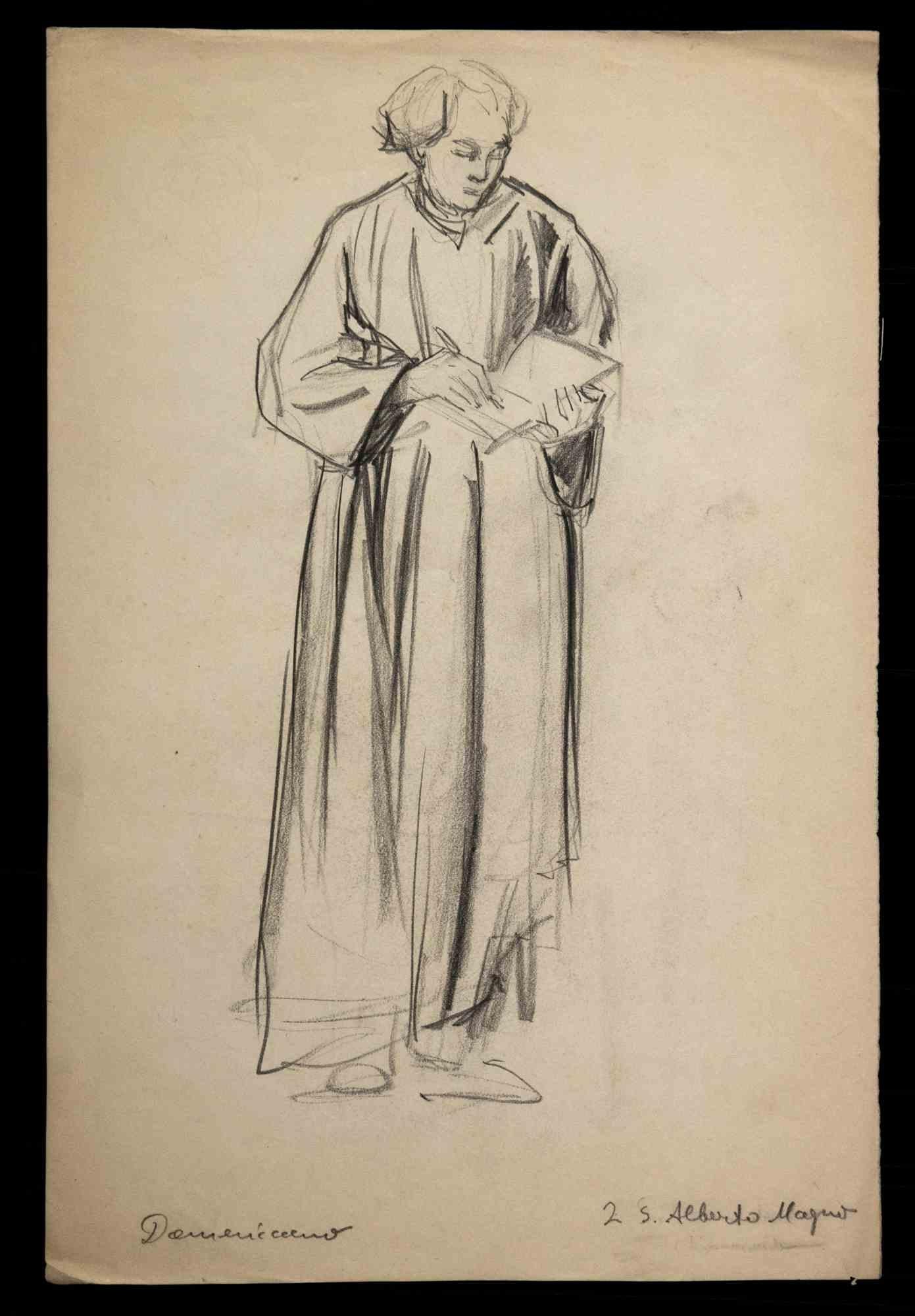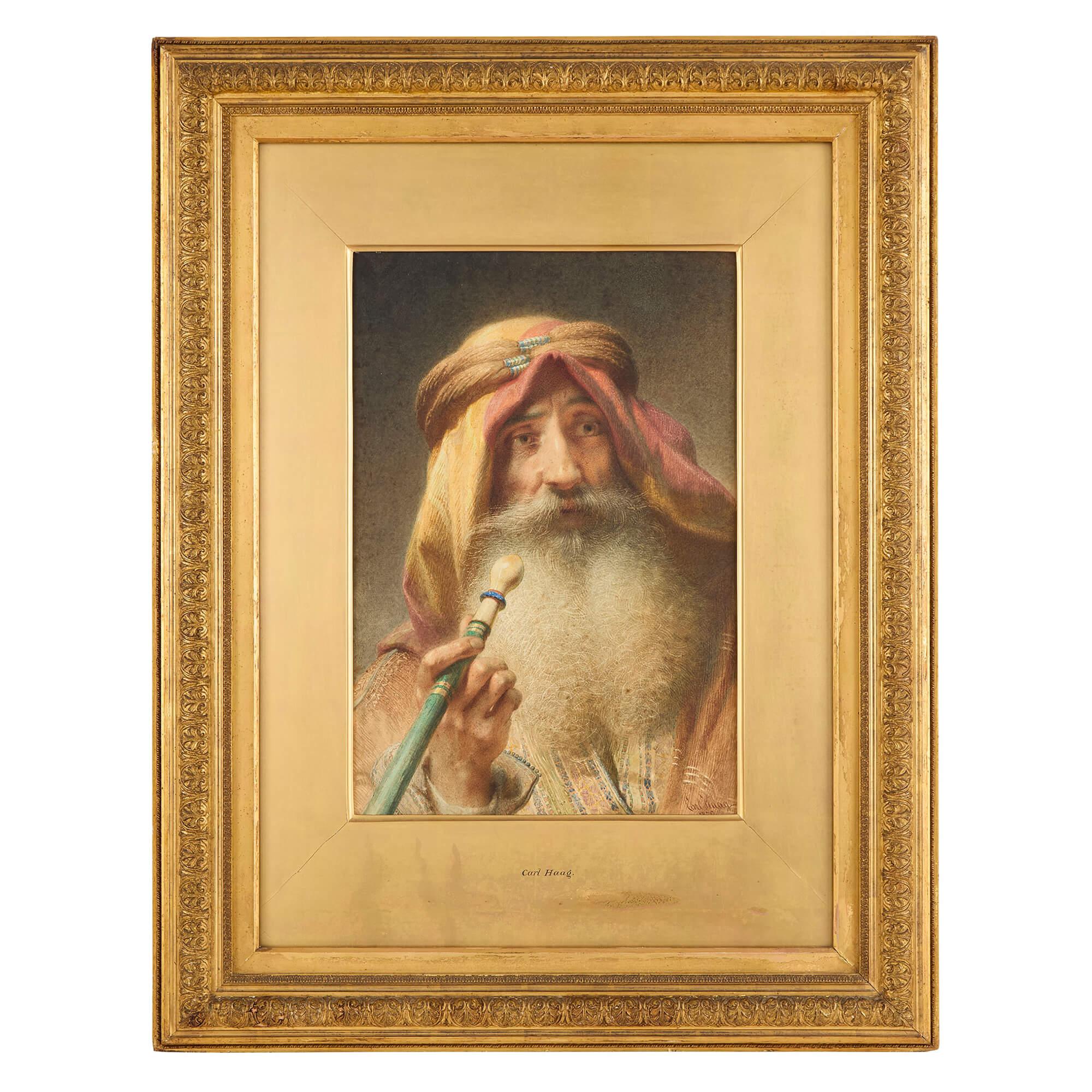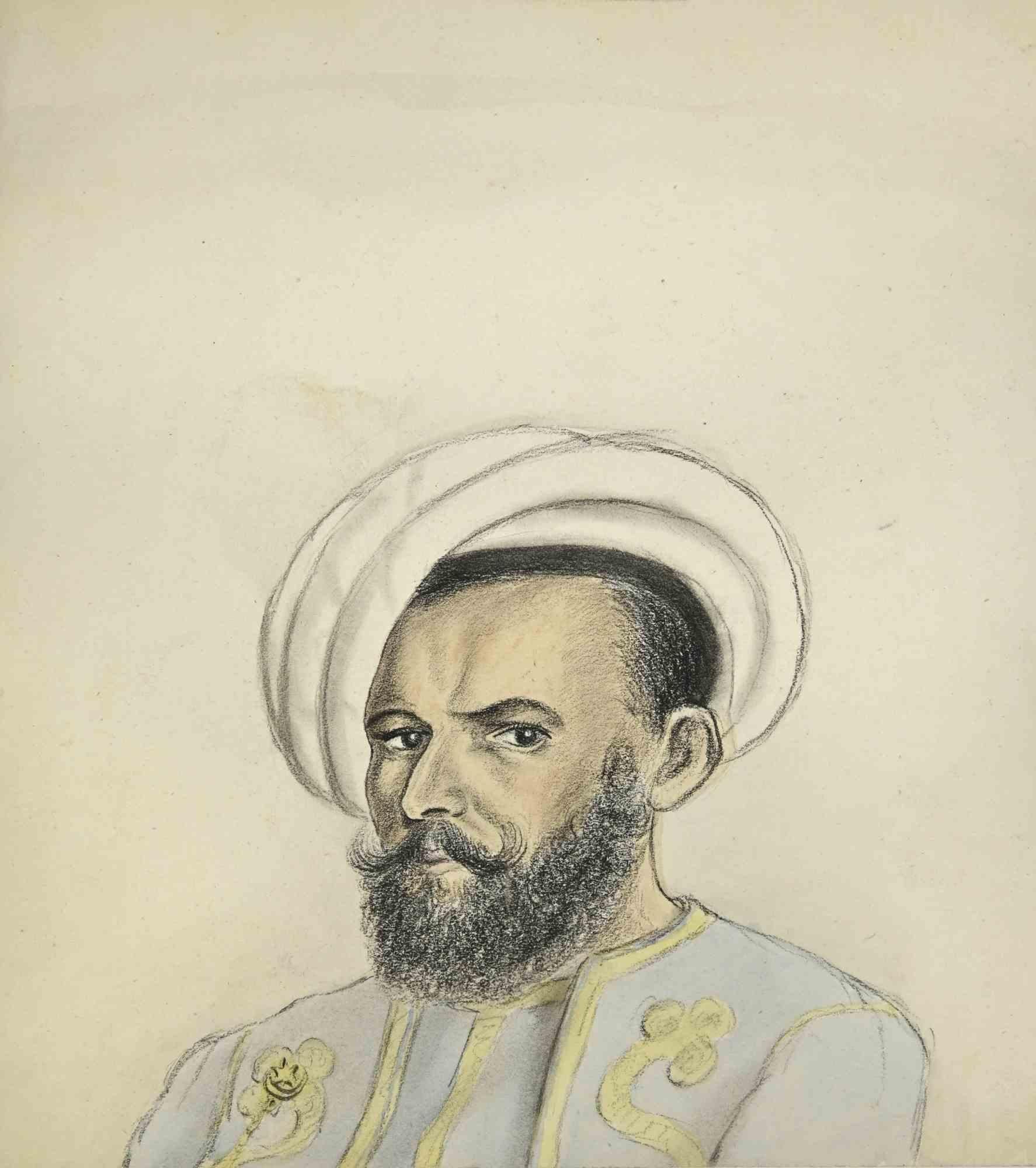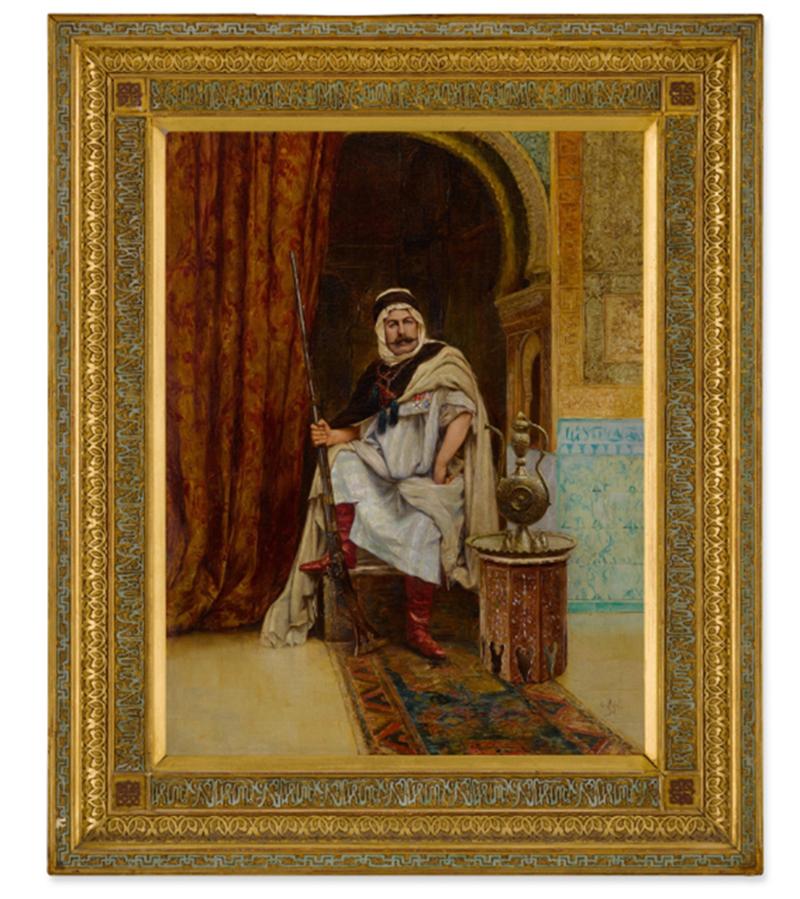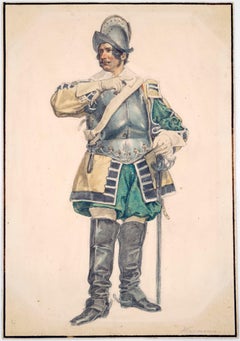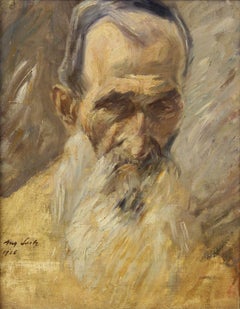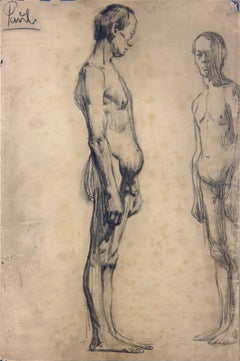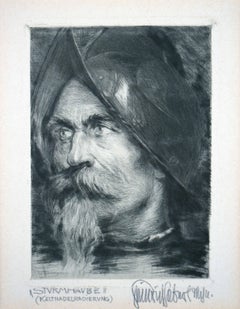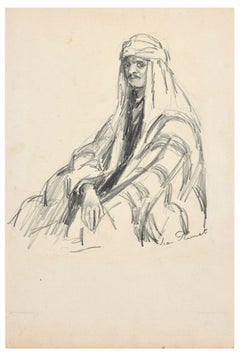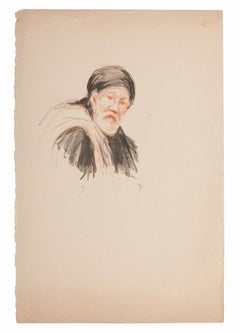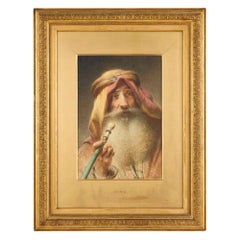Items Similar to Half-length portrait of a Pharisee - In the shadow of betrayal -
Want more images or videos?
Request additional images or videos from the seller
1 of 8
Hermann PrellHalf-length portrait of a Pharisee - In the shadow of betrayal -1885
1885
$1,437.29
$1,796.6120% Off
£1,065.11
£1,331.3920% Off
€1,200
€1,50020% Off
CA$1,962.17
CA$2,452.7120% Off
A$2,182.83
A$2,728.5420% Off
CHF 1,144.27
CHF 1,430.3420% Off
MX$26,673.71
MX$33,342.1320% Off
NOK 14,570.84
NOK 18,213.5520% Off
SEK 13,716.43
SEK 17,145.5420% Off
DKK 9,136.69
DKK 11,420.8720% Off
Shipping
Retrieving quote...The 1stDibs Promise:
Authenticity Guarantee,
Money-Back Guarantee,
24-Hour Cancellation
About the Item
Hermann Prell (1854 Leipzig - 1922 Dresden-Loschwitz). Half-length portrait of a Pharisee, 1885. Sketch for the right-hand figure in the painting Judas Iscariot, 1886. Pencil drawing heightened with opaque white and black chalk on beige-grey wove paper (papier vélin), 34 x 27.8 cm (visible size), 52 x 45 cm (mount), signed, dated and inscribed "H. PRELL 1885 zu 'Judas'".
Minor browning, collection stamp on the reverse.
- In the shadow of betrayal -
About the artwork
This painting is the sketch for the head of the Pharisee offering the coins to Judas in one of Herrmann Prell's major works, the painting Betrayal of Judas, completed in 1886. The painting belongs to the Staatliche Kunstsammlungen Dresden and is illustrated in Adolf Rosenberg: Prell, Bielefeld and Leipzig 1901, p. 21 (Fig. 19). It is especially highlighted in Thieme-Becker (vol. 27, p. 376).
Hermann Prell, Betrayal of Judas, 1886
The monumental head, which fills the picture and is distinguished by its ornamented robe, is almost a lost profile, which in the executed painting is justified by the Pharisee's turning towards Judas. Despite the fact that the sitter withdraws from the viewer by turning away, it was necessary to artistically elaborate the motivation for the purchase of one of Christ's disciples, which is why the drawing focuses on the expression of the face, while the 'accessories' are treated in a more summary manner.
In characterising the face, Hermann Prell performs a balancing act: since the Pharisee, despite his destructive actions, is an actor in the history of salvation, the head must show a dignity appropriate to the event, but at the same time the physiognomy must also bear witness to the scheming attitude that led to the betrayal. To solve this dilemma, Prell draws on the traditional depictions of the heads of the apostles, shading the face to indicate the obdurate darkness of the spirit and moving the base of the nose slightly upwards while the mouth falls away, thus giving a physiognomic expression to the motivation of the action. The fatal drama of the betrayal is expressed in the monumentalisation of the head and in the thunderous white highlights that contrast with the darkness of the chalk.
As a study, considered by the artist to be a work in itself, this drawing reveals the pictorial problems and brainstorming of monumental painting.
About the artist
In 1872 Prell, who was one of the most important exponents of monumental painting of his time, began studying painting with Theodor Grosse at the Dresden Academy of Art and continued with Carl Gussow at the Berlin Academy in 1876. Hans von Marées taught him in Rome in 1878. More influential on his work, however, were Arnold Böcklin and Max Klinger, with whom Prell had been friends since his student days and with whom he worked together on several occasions.
Prell's first major work, which established his reputation as a monumental painter, were the frescoes in the banqueting hall of the Architektenhaus in Berlin in 1881/82, commissioned by the state and depicting the different periods of architecture. Prell then went to Italy for two years to study fresco painting. Other major commissions followed. These included monumental frescoes in the town halls of Worms (1884), Hildesheim (1882-92), Gdansk (1895) and Dresden, the staircase of the Silesian Museum of Fine Arts in Breslau (1893/94), the throne room of the German Embassy in Rome (1896-99) and the staircase of the Albertinum in Dresden (1900-1904).
From 1886 Prell taught at the academy of arts in Berlin and in 1892 he was appointed professor at the academy of arts in Dresden. His students included Osmar Schindler and Hans Unger. During his time in Dresden Prell belonged to the group around Carl Bantzer, who later formed the Goppeln artists' colony.
An extensive collection of Hermann Prell's works is kept at the Städtische Galerie Dresden. Otto Schiller and Martin Schauss made busts of Hermann Prell and Walter Witting a medal of honour. In the Roemer Museum in Hildesheim a whole room was once dedicated to Hermann Prell. Many of Prell's important works were lost in 1945.
Selection of public collections that own works by Hermann Prell:
Albertinum Dresden, Städtische Kunstsammlung Chemnitz, Stadtmuseum Bautzen.
Selected bibliography
Adolf Rosenberg: Prell. Mit 115 Abbildungen nach Gemälden, Zeichnungen und Skulpturen, Bielefeld 1901.
George Galland: Hermann Prell. Fresken, Skulpturen und Tafelbilder des Meisters, Leipzig 1916.
Hartwig Fischer: Ein Wilhelminisches Gesamtkunstwerk auf dem Kapitol. Hermann Prell und die Einrichtung des Thronsaals in der Deutschen Botschaft zu Rom 1894–1899. Hamburg 1998.
Christel Wünsch: Hermann Prell. In: Die Kunst hat nie ein Mensch allein besessen. Dreihundert Jahre Akademie der Künste und Hochschule der Künste Berlin. Katalog Akademie der Künste und Hochschule der Künste, Berlin 1996, S. 317–319.
Heike Biedermann, Katrin Bielmeier: "Aber befreit empor zum Äther kreisen die Musen". Zur Ausgestaltung des Treppenhauses im Albertinum durch Hermann Prell. In: Dresdener Kunstblätter 54,4 (2010), S. 228-232.
GERMAN VERSION
Hermann Prell (1854 Leipzig - 1922 Dresden-Loschwitz). Brustbild eines Pharisäers, 1885. Studie zur rechten Figur zum Gemälde "Judas Ischarioth" von 1886. Mit Deckweiß gehöhte Zeichnung in Bleistift und schwarzer Kreide auf beigegrauem Velin, 34 x 27,8 cm, 52 x 45 cm (Passepartout), signiert, datiert und bezeichnet "H. PRELL 1885 zu 'Judas'".
Minimal gebräunt, Ränder mit Klebestreifen hinterlegt, rückseitig Sammlungsstempel.
Exposé als PDF
- Im Schatten des Verrats -
zum Werk
Das Bild ist der Entwurf für den Kopf desjenigen Pharisäers, der Judas auf einem der Hauptwerke Herrmann Prells, dem 1886 vollendeten Gemälde "Verrat des Judas", Judas die Münzen darbietet. Das Gemälde gehört den Staatliche Kunstsammlungen Dresden und ist abgebildet in: Adolf Rosenberg: Prell, Bielefeld und Leipzig 1901, S. 21 (Abb. 19). Im Thieme-Becker wird es eigens hervorgehoben (Bd. 27, S. 376).
Hermann Prell, Der Verrat des Judas, 1886
Der bildfüllende durch das ornamentierte Prunkgewand ausgezeichnete, monumental wirkende Kopf ist beinahe ins verlorene Profil gewendet, was auf dem ausgeführten Gemälde durch die Hinwendung des Pharisäers zu Judas begründet ist. Trotzdem sich der Dargestellte dem Betrachter durch seine Abwendung entzieht, galt es, die Motivation des Kaufs einer der Jünger Christi künstlerisch herauszuarbeiten, weshalb die Zeichnung auf die Ausprägung des Gesichtsausdrucks fokussiert ist, während das 'Beiwerk' eine eher summarische Behandlung erfährt. Bei der Charakterisierung des Gesichts meistert Hermann Prell eine Gradwanderung: Indem der Pharisäer trotz seines zerstörerischen Handelns ein Akteur der Heilsgeschichte ist, hat der Kopf eine diesem Geschehen entsprechende Würde aufzuweisen, zugleich muss die Physiognomie aber auch von der intriganten, den Verrat in die Wege leitenden Einstellung zeugen. Zur Lösung dieses Dilemmas bezieht sich Prell auf traditionelle Darstellungen von Apostelköpfen, verschattet das Gesicht, um die verstockte Dunkelheit des Geistes anzuzeigen und rückt den Nasenansatz leicht hoch, während die Mundpartie abfällt, wodurch der Motivation des Handelns ein physiognomischer Ausdruck gegeben wird. Die am Verrat hängende fatale Dramatik kommt in der Monumentalisierung des Kopfes ebenso zum Ausdruck wie in den gewitterartig aufleuchtenden Weißhöhungen, die mit dem Dunkel der Kreide kontrastieren. In Form einer vom Künstler selbst als eigenständiges Werk angesehen Studie werden anhand dieser Zeichnung die Bildprobleme und die Ideenfindung der Monumentalmalerei sichtbar.
zum Künstler
1872 nahm Prell, der zu den wichtigsten Vertretern der Monumentalmalerei seiner Zeit zählt, das Studium der Malerei an der Dresdner Kunstakademie bei Theodor Grosse auf und setzte es 1876 bei Carl Gussow an die Berliner Akademie fort. 1878 unterrichtete ihn Hans von Marées in Rom. Prägender für sein Oeuvre wurden allerdings Arnold Böcklin und Max Klinger, mit welchem Prell seit Studienzeiten befreundet war und mehrfach zusammenarbeitete.
Prells erste größere Arbeit, die seinen Ruf als Monumentalmaler begründete, sind die in Staatsauftrag 1881/82 geschaffenen Fresken des Festsaales im Berliner Architektenhaus, auf denen die Epochen der Baukunst dargestellt sind. Im Anschluss daran ging Prell zwei Jahre nach Italien, um intensiv die Freskomalerei zu studieren. Es folgen weitere Großaufträge. Darunter Monumentalfresken in den Rathäusern von Worms (1884), Hildesheim (1882-92), Danzig (1895) und Dresden, die Ausmalung des Treppenhauses des Schlesischen Museums der bildenden Künste in Breslau (1893/94), des Thronsaales der Deutschen Botschaft in Rom (1896-99) und des Treppenhauses des Albertinums in Dresden (1900-1904).
Seit 1886 lehrte Prell an der Berliner Kunstakademie, 1892 erfolgte die Berufung zum Professor an die Dresdner Kunstakademie, um dort das Meisteratelier für Geschichtsmalerei zu leiten. Unter seinen Schülern waren Osmar Schindler und Hans Unger. In seiner Dresdner Zeit gehörte Prell zur Gruppe um Carl Bantzer, aus der sich später die Künstlerkolonie Goppeln formierte.
Ein umfangreiches Konvolut aus dem Nachlass von Hermann Prell wird in der Städtischen Galerie Dresden aufbewahrt. Otto Schiller und Martin Schauss haben Büsten und Walter Witting eine Ehrenmedaille Hermanns Prells angefertigt. Im Roemer-Museum Hildesheim war Hermann Prell ehemals ein ganzer Saal gewidmet. 1945 gingen eine Vielzahl bedeutender Werke Prells verloren.
"Ausgehend von Studien setzte Prell auf einen auf den Formen der Hochrenaissance basierenden Idealstil, der aber auf naturalistisch-illusionistische Wirkung zielte. In der Gesamtkomposition seiner Zyklen war Prell bestrebt, die Wand im Sinne des Barock zu ignorieren und durch fiktive Durchbrechungen derselben dem Besucher das Gefühl der Raumerweiterung zu geben."
Hans Vollmer im Thieme-Becker
Auswahl öffentlicher Sammlungen, die Werke von Hermann Prell besitzen:
Albertinum Dresden, Städtische Kunstsammlung Chemnitz, Stadtmuseum Bautzen.
Auswahlbibliographie
Adolf Rosenberg: Prell. Mit 115 Abbildungen nach Gemälden, Zeichnungen und Skulpturen, Bielefeld 1901.
George Galland: Hermann Prell. Fresken, Skulpturen und Tafelbilder des Meisters, Leipzig 1916.
Hartwig Fischer: Ein Wilhelminisches Gesamtkunstwerk auf dem Kapitol. Hermann Prell und die Einrichtung des Thronsaals in der Deutschen Botschaft zu Rom 1894–1899. Hamburg 1998.
Christel Wünsch: Hermann Prell. In: Die Kunst hat nie ein Mensch allein besessen. Dreihundert Jahre Akademie der Künste und Hochschule der Künste Berlin. Katalog Akademie der Künste und Hochschule der Künste, Berlin 1996, S. 317–319.
Heike Biedermann, Katrin Bielmeier: "Aber befreit empor zum Äther kreisen die Musen". Zur Ausgestaltung des Treppenhauses im Albertinum durch Hermann Prell. In: Dresdener Kunstblätter 54,4 (2010), S. 228-232.
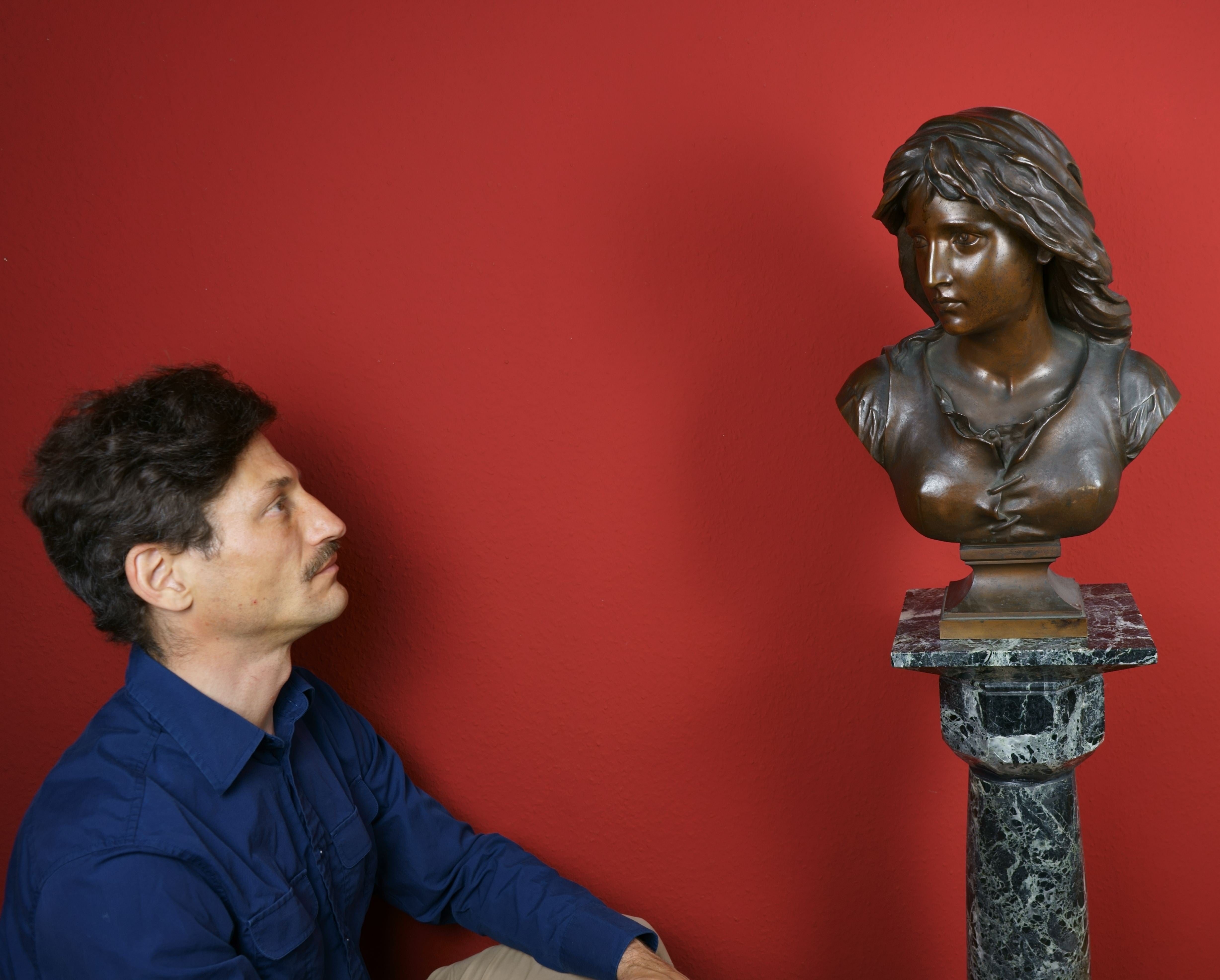
About the Seller
5.0
Gold Seller
Premium sellers maintaining a 4.3+ rating and 24-hour response times
Established in 2014
1stDibs seller since 2023
20 sales on 1stDibs
- ShippingRetrieving quote...Shipping from: Berlin, Germany
- Return Policy
Authenticity Guarantee
In the unlikely event there’s an issue with an item’s authenticity, contact us within 1 year for a full refund. DetailsMoney-Back Guarantee
If your item is not as described, is damaged in transit, or does not arrive, contact us within 7 days for a full refund. Details24-Hour Cancellation
You have a 24-hour grace period in which to reconsider your purchase, with no questions asked.Vetted Professional Sellers
Our world-class sellers must adhere to strict standards for service and quality, maintaining the integrity of our listings.Price-Match Guarantee
If you find that a seller listed the same item for a lower price elsewhere, we’ll match it.Trusted Global Delivery
Our best-in-class carrier network provides specialized shipping options worldwide, including custom delivery.More From This Seller
View AllThe actor Karl Seydelmann, probably as Max Piccolomini / - Theatrical Realism -
Located in Berlin, DE
Theodor Hosemann (1807 Brandenburg - 1875 Berlin), The actor Karl Seydelmann probably as Max Piccolomini, around 1840. Watercolor with pencil, 20.5 cm (height) x 14.7 cm (width), sig...
Category
1840s Realist Figurative Drawings and Watercolors
Materials
Paper
Half-length portrait of an elderly bearded man - Melancholy of a prophet -
Located in Berlin, DE
Friedrich August Seitz (1902 Staffort - 1944 Belgrade). Half-length portrait of an elderly man with a beard. Oil on canvas, 42 x 34 cm (visible seize), 58 x 50 cm (frame), signed and...
Category
1920s Expressionist Figurative Paintings
Materials
Oil
Self-portrait - Homo nudus -
Located in Berlin, DE
Bruno Paul (1874 Seifhennersdorf - 1968 Berlin). Self-portrait, c. 1895. Pencil on paper, mounted on cardboard, 53.5 x 35 cm, signed 'Paul' at upper left.
- Homo nudus -
About the artwork
In a mirrored situation, Bruno Paul looks at himself in the picture. While his body, which is the size of the format, is shown in profile parallel to the picture, he turns his head into the picture in order to become aware of himself there, whereby the lighter use...
Category
1890s Realist Figurative Drawings and Watercolors
Materials
Pencil
$3,353 Sale Price
20% Off
Balaclava - The target in sight -
Located in Berlin, DE
Heinrich Haberl (1869 Passau to 1934 Munich), Sturmhaube, c. 1900. drypoint, 14 x 10 cm (platemark), 28 x 21 cm (sheet size), 39 x 29 cm (passe-partout), titled "Sturmhaube" in lead at lower left and inscribed "Kaltnadelradierung", signed and locally inscribed "Heinrich Haberl Mchn. [Munich]" at lower right, inscribed again in lead on verso and with old collection stamp.
- slightly darkened, fixed and mounted
- The target in sight -
About the artwork
The theatrical "role-portrait" is to be seen against the background of the Rembrandt cult, which reached its climax at the end of the 19th century. The soldier seems to have stepped straight out of Rembrandt's Night Watch (1642) to fix something outside the picture with an alert and ready gaze. The steeply rising brim of the morion frames the gaze and thus perspectivises it as the actual 'pictorial action'. The gaze represents both the vigilant defence and the visionary goal of the battle.
Not only the subject, but also the style of the etching needle reflect Rembrandt's understanding of the times. Strong contrasts of light and dark are created in a virtuoso free stroke, without losing the effect of the reflections on the helmet and in the eyes. This shows a kinship with the early prints of Lovis Corinth, who also saw himself as an artist in the role of the knight. Against this background, Haberl's picture can also be seen as a representation of his artistic self-image.
About the artist
Heinrich Haberl first attended the art school in Nuremberg and from 1892 studied at the Munich Academy. There he was a master student of Johann Leonhard von Raab, Rudolf von Seitz, Franz von Defregger...
Category
Early 19th Century Realist Figurative Prints
Materials
Etching
$229 Sale Price
20% Off
Man sitting in the studio - Thinking about art -
Located in Berlin, DE
Adolph Eduard Otto von Faber du Faur (1828 Ludwigsburg - 1901 Munich). Man sitting in the studio. Watercolour painting, 43 x 27 cm (visible size), 73 x 53 cm (frame), monogrammed at lower right, estate stamp.
Upper right corner neatly repaired, small tear in the wall to the left of the sitter.
- Thinking about art -
About the artwork
The sitter, an elderly man, is seated in a studio on a pedestal reminiscent of an academy hall. The earthy, dark tones give the scene a weighty quality. The lightest tones are found in the incarnate parts of the figure, which do not stand out from the other colours of the picture, but are linked to them. As a result, the sitter's face is both part of and the highlight of the colour references in the picture. The colour of the sitter's skin is reflected in his pink coat, while his white-grey hair matches the colour of the wall next to him. This almost monochrome wall surface, in turn, is connected across the portrait to the framed picture standing on the floor, which seems to have been erased by this correspondence with the empty wall surface. Through the palette, which is positioned directly behind the sitter's head, the reference to painting, which is already given by the studio space, is explicitly linked to the sitter, who thus seems to be contemplating the question of the meaning of art.
This raises the question of whether Faber Du Faur, who had become lonely in his old age, might have painted a self-portrait here in his later years. In addition to the studio setting, the sitter's explicit reference to the palette and the fact that the picture was part of his estate, the only summary elaboration of the body suggests a self-portrait, while the representation of the face is concretised with the wide-open eyes typical of a self-portrait. This concentration on the face gives the impression of the artist's melancholy introspection, captured by the palette and related to the meaning of painting, whose dark character is reinforced by the concealment of the palette hanging on the right of the picture in the light tones so characteristic of Faber Du Faur. In the course of this resignation, Faber du Faur advises his son Hans, who has also become a painter: "Promise me one thing: never move to Munich, they'll kill you here!"
Whoever the sitter may be, the references to painting make the portrait a resigned self-contemplation by Faber Du Faur, focused on art.
About the artist
After leaving school, Otto Faber du Faur entered the service of the Württemberg army, at the same time cultivating his artistic talent. In 1851, on the recommendation of his father Christian Wilhelm, who was himself a battle painter, he spent six months in Munich as an apprentice to Alexander von Kotzebue. In 1852 he was granted a year's leave of absence from military service to study battle painting in the studio of Adolphe Yvon...
Category
1890s Realist Portrait Drawings and Watercolors
Materials
Watercolor
$910 Sale Price
20% Off
The actor Karl Seydelmann as soldier / - The expressiveness of a simple pose -
Located in Berlin, DE
Theodor Hosemann (1807 Brandenburg - 1875 Berlin), The actor Karl Seydelmann as soldier, around 1840. Watercolor in pencil, 22 cm (height) x 14.7 cm (width), signed “Th.[eodor] Hosem...
Category
1840s Realist Figurative Drawings and Watercolors
Materials
Paper
You May Also Like
Portrait of Arab - Original Charcoal Drawing by Jean Plumet - Early 20th Century
By Jean Louis Plumet
Located in Roma, IT
Portrait of Arab is an interesting drawing realized by the French artist Jean Louis Plumet. It is in very good conditions, except for some tiny stains and a fold on the lower part of...
Category
Early 20th Century Modern Figurative Drawings and Watercolors
Materials
Charcoal
The Old Arab Man - Original Watercolor on Paper - 19th Century
Located in Roma, IT
The Old Man is an original drawing in watercolor on paper realized by Anonymous Artist of the 19th Century.
Monogrammed on the lower left in pencil
The state of preservation of the...
Category
19th Century Figurative Drawings and Watercolors
Materials
Paper, Watercolor
Portrait of Albertus Magnus - Original Drawing - Early 20th Century
Located in Roma, IT
Portrait of Albertus Magnus is an original drawing in pencil realized by an anonymous artist in the early 20th Century.
Good conditions except for being aged.
The artwork is depict...
Category
Early 20th Century Modern Figurative Drawings and Watercolors
Materials
Pencil
Mashallah Antique Large German Orientalist Watercolour Portrait Carl Haag
By Carl Haag
Located in London, GB
Mashallah Antique Large German Orientalist Watercolour Portrait Carl Haag
German, 1870
Paper: Height 50cm, width 34cm
Frame: Height 90cm, width 70cm, depth 8cm
This captivating wate...
Category
Late 19th Century Figurative Paintings
Materials
Paper, Watercolor
Portrait of General - Drawing by Charles de Bozolez - Mid-20th Century
Located in Roma, IT
Portrait of General is a drawing in pencil on paper realized in the 1950s by Charles de Bozolez
The state of preservation is good.
The artwork represents the portrait of General th...
Category
Mid-20th Century Modern Figurative Drawings and Watercolors
Materials
Pencil
Clemente Pujol de Gustavino An orientalist Arab Guardsman
Located in New York, NY
Artist: Clemente Pujol de Guastavino (1850-1905)
Origin: Spanish
Signature: signed C. Pujol (lower right)
Medium: oil on canvas
Dimension: 25 1/2 in x 19 3/4 in. Framed 34 by 2...
Category
19th Century Portrait Drawings and Watercolors
Materials
Canvas, Oil
